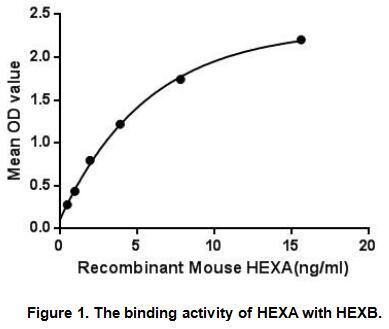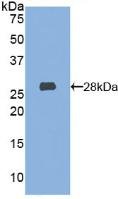Active Hexosaminidase A Alpha (HEXa) 

TSD; Hex-A; Tay Sachs Disease; GM2 Gangliosidosis; Beta-Hexosaminidase Subunit Alpha; Beta-N-Acetylhexosaminidase Subunit Alpha; N-Acetyl-Beta-Glucosaminidase Alpha
- UOM
- FOB US$ 334.00 US$ 835.00 US$ 1,670.00 US$ 5,010.00 US$ 12,525.00
- Quantity
Overview
Properties
- Product No.APA195Mu01
- Organism SpeciesMus musculus (Mouse) Same name, Different species.
- ApplicationsCell culture; Activity Assays.
Research use only - DownloadInstruction Manual
- CategoryEnzyme & KinaseMetabolic pathway
- Buffer Formulation20mM Tris, 150mM NaCl, pH8.0, containing 1mM EDTA, 1mM DTT, 0.01% SKL, 5% Trehalose and Proclin300.
- Traits Freeze-dried powder, Purity > 97%
- Isoelectric Point6.3
Sign into your account
Share a new citation as an author
Upload your experimental result
Review

Contact us
Please fill in the blank.
Activity test

Hexosaminidase A Alpha (HEXa) is a lysosomal enzyme. There are three predominant isoenzymes: hexosaminidase A, B and S. Hexosaminidase A and the cofactor GM2 activator protein catalyze the degradation of the GM2 gangliosides and other molecules containing terminal N-acetyl hexosamines. The enzymes are composed of two alpha and/or beta subunits, which are coded by HEXA and HEXB genes, respectively. Even though the alpha and beta subunits of hexosaminidase A can both cleave GalNAc residues, only the alpha subunit which contains a key residue, Arg-424 is able to hydrolyze GM2 gangliosides. Hexosaminidase A (alpha polypeptide) plays a critical role in the brain and spinal cord (central nervous system). Besides, Hexosaminidase B Beta (HEXB) has been identified as an interactor of HEXA, thus a binding ELISA assay was conducted to detect the interaction of recombinant mouse HEXA and recombinant mouse HEXB. Briefly, HEXA were diluted serially in PBS, with 0.01% BSA (pH 7.4). Duplicate samples of 100uL were then transferred to HEXB-coated microtiter wells and incubated for 2h at 37℃. Wells were washed with PBST and incubated for 1h with anti-HEXA pAb, then aspirated and washed 3 times. After incubation with HRP labelled secondary antibody, wells were aspirated and washed 3 times. With the addition of substrate solution, wells were incubated 15-25 minutes at 37℃. Finally, add 50µL stop solution to the wells and read at 450nm immediately. The binding activity of of HEXA and HEXB was shown in Figure 1, and this effect was in a dose dependent manner.
Usage
Reconstitute in 20mM Tris, 150mM NaCl (pH8.0) to a concentration of 0.1-1.0 mg/mL. Do not vortex.
Storage
Avoid repeated freeze/thaw cycles. Store at 2-8°C for one month. Aliquot and store at -80°C for 12 months.
Stability
The thermal stability is described by the loss rate. The loss rate was determined by accelerated thermal degradation test, that is, incubate the protein at 37°C for 48h, and no obvious degradation and precipitation were observed. The loss rate is less than 5% within the expiration date under appropriate storage condition.
Increment services
-
 BCA Protein Quantification Kit
BCA Protein Quantification Kit
-
 Molecular Mass Marker for Protein
Molecular Mass Marker for Protein
-
 Monoclonal Antibody Customized Service
Monoclonal Antibody Customized Service
-
 Polyclonal Antibody Customized Service
Polyclonal Antibody Customized Service
-
 Protein Activity Test Experiment Service
Protein Activity Test Experiment Service
-
 Electrophoretic Mobility Shift Assay (EMSA) Experiment Service
Electrophoretic Mobility Shift Assay (EMSA) Experiment Service
-
 Buffer
Buffer
-
 Lentivirus Packaging Experiment Service
Lentivirus Packaging Experiment Service
-
 Adenovirus Packaging Experiment Service
Adenovirus Packaging Experiment Service
-
 Real Time PCR Experimental Service
Real Time PCR Experimental Service
-
 Spike RBD Protein (S-RBD)
Spike RBD Protein (S-RBD)
-
 Protein G
Protein G
-
 Protein A
Protein A
Citations
- Functionality of a bicistronic construction containing HEXA and HEXB genes encoding ¦Â-hexosaminidase A for cell-mediated therapy of GM2 gangliosidoses34100447
- Serum Cytokine Profile, Beta-Hexosaminidase A Enzymatic Activity and GM2 Ganglioside Levels in the Plasma of a Tay-Sachs Disease Patient after Cord Blood Cell …34685379








